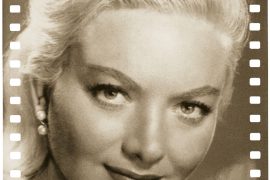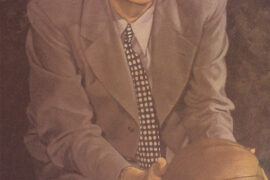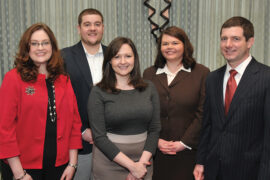… distinguished professor of history, family man and Southern gentleman.
By Dr. David R. Woodward
HQ 33 | AUTUMN 1998
I first met Dr. Charles Hill Moffat in the Fall of 1969. Arriving at the Charleston airport for an interview for a position at Marshall University, I was met by a courtly Southerner with a lovely Mississippi accent. I could have found no greater advocate for Huntington during my first visit to West Virginia. He took me on the first of what became many “Moffat tours” of the city. He thought Huntington “the most beautiful and desirable city in West Virginia” with its “magnificent blend of mountains and river” and its “spacious boulevards.”
I eventually received a job in the History Department, but just as importantly, I gained a friend and mentor.
As chair of the department, Dr. Moffat and his faculty ate lunch at Jim’s every Thursday. Long after he retired from Marshall though, I continued to lunch with him at the popular restaurant. He was an entertaining storyteller with an almost photographic memory, and we often talked about his life, Huntington and Marshall University. Over time, I developed a unique insight into one of Marshall’s best known and beloved instructors.
Born in Houston, Mississippi in the year that the “Titanic” sank, 1912, he was an only child. His family soon moved to Senatobia where he had an active and carefree childhood in the small town in the northwest part of the state. He played baseball and, in one of his proudest moments, stood up to the school bully. To earn money, he mowed lawns, delivered newspapers and chauffeured for a disabled rich man. He also accompanied his father, an attorney, on many business trips. His speaking ability may have come from his father who was a renowned orator in his own right, speaking often at commencement exercises and church functions.
At the age of 14, he was stricken with polio. Cures were sought, including a visit to the Tuskegee Institute where the famous Dr. George Washington Carver massaged his affected left leg with peanut oil.
“It was at this time,” Dr. Moffat later wrote in his unpublished memoirs, “that I realized I would be forced to live a sedentary life. History had always been my favorite subject and I determined to aspire to become a college history professor.”
Graduating from the University of Mississippi with a B.A., he went on to earn his M.A. and his Ph.D. at the University of Mississippi and Vanderbilt University respectively. He also taught history in high school at Gordo, Alabama, where he courted and married Mary Louise Wright.
In 1946 he arrived in Huntington to begin his more than three decades of teaching at Marshall. When he arrived, Cam Henderson was coaching the basketball and football teams and Dr. Stewart Howard Smith had just begun his long tenure as president. Although the oldest institution of higher education in West Virginia, Marshall College had a small faculty and a modest campus. The newest building was the handsome library which had been completed in 1937; no classroom building had been erected since 1915.
Dr. Moffat was part of the postwar wave of professors who transformed this small college into a university.
Prior to World War II, Marshall College played a minor role in the life of Huntington which had a growing economy and expanding population. The school was appreciated but had little status. George S. Wallace’s Huntington Through Seventy-Five Years, published in 1947, mentions Marshall in the section that examines all of the city’s schools but no faculty member or administrator was included in Wallace’s section on “prominent people.” The police and fire departments received more ink.
No professor during the next four decades was to make greater contributions in bringing town and gown together. Dr. Moffat’s affection for the city was obvious to all, and he played an active role in the community, serving as a senior deacon in the Fifth Avenue Baptist Church and as president of the Kiwanis Club. But it was his off-campus speeches that made him unique in the history of the college. His talks on such topics as “The Presidents’ Wives” and “Americans Who Stood on Principle Rather than Expediency” put him much in demand. He gave hundreds of talks to local political, religious and civic organizations. His reputation soon spread beyond Huntington, and he spoke at most of the state colleges and at many high schools.
He lectured to both the Chicago Executives Club and the Cincinnati Corporate Managers Club. The U.S. Army also called him into service. Invitations to speak came from West Point, the Command and General Staff College at Fort Leavensworth, the Engineers College at Fort Belvoir and the Provost Marshal School at Fort Gordon. In 1962 the Defense Department sent him on a lecture tour to the Far East. His public appearances made him Marshall’s most-recognized professor.
He was equally popular on campus with students. His courses on the Civil War, the South and the American frontier were in great demand. “Did you have Dr. Moffat?” was a question often asked of Marshall graduates.
Speaking with a dramatic flair, he made history come alive for thousands of students. Despite his heavy teaching load, there was never any “burn out.” He was always “up” for his lectures. “I gave them their money’s worth,” was his creed.
Dr. Alan B. Gould, the Executive Director of the John Deaver Drinko Center and one of Dr. Moffat’s former students, described one of his classes: “Dr. Moffat is one of the most informative and imaginative lecturers I have ever heard. His classroom techniques included the dexterous and dazzling employment of a cane which was exceeded in effect only by the eloquence of his oratory. With the finesse of a fencing master, he wheeled his cane as an instrument to emphasize dramatic incidents in history, as a pointer for locating historical sites on maps and as a baton in directing the tempo and meter of his finely honed lectures. With only an outline illegibly scribbled on a blackboard, Dr. Moffat created descriptive mosaics embellished by a broad Southern accent which only heightened interest in his spellbinding performances brimming with content.”
His curiosity and love of travel also enlivened his lectures. “I resolved at the outset of my career to visit as many places as possible that had any historical importance,” he said.
His classroom demeanor was friendly but formal. Dressed neatly in coat and tie, his lectures were always intriguing. Matching or true and false questions had no place in his examinations. He expected and got the best from his students with demanding essay questions. Dr. Moffat was a lecturer and no one served as a better representative for this teaching method. He took a balanced approach to his presentation of American history, did not impose his political views, and remained as popular with stu- dents of the sixties and seventies as he had been with their parents.
A mandatory retirement policy that is no longer in effect forced Dr. Moffat to retire from full-time teaching at Marshall in 1977.
But Dr. Moffat never truly retired as he soon became a prolific writer. His publications include histories of Marshall University and the Cabell County Medical Society as well as a biography of Ken Hechler. And he remained in the classroom. He had been a part-time instructor at Ohio University at Portsmouth and Ironton in the evenings since 1953, and he continued to teach across the Ohio River until he finally stepped away from the podium in the mid-1990s.
Dr. Moffat has not been forgotten by his university and community. The History Department established a Visiting Lectureship in his name, he was awarded an honorary degree by the university in 1980, and more recently President J. Wade Gilley established the Charles H. Moffat Fund for Excellence in Teaching. The Huntington Foundation, recognizing his many contributions to his school and community, selected him in 1989 for inclusion in the Huntington Wall of Fame.
Marshall University is today a major educational institution as reflected in the dramatic growth of its campus. Dr. Moffat, however, serves as a reminder that a university is much more than bricks and mortar. The life blood of every university remains its faculty. Dr. Moffat was joined by many of his fellow faculty in making the university what it is today. Many of these instructors have not received the credit that they richly deserve. Fortunately this has not been the case with Charles Hill Moffat, distinguished professor of history, family man and Southern gentleman.





